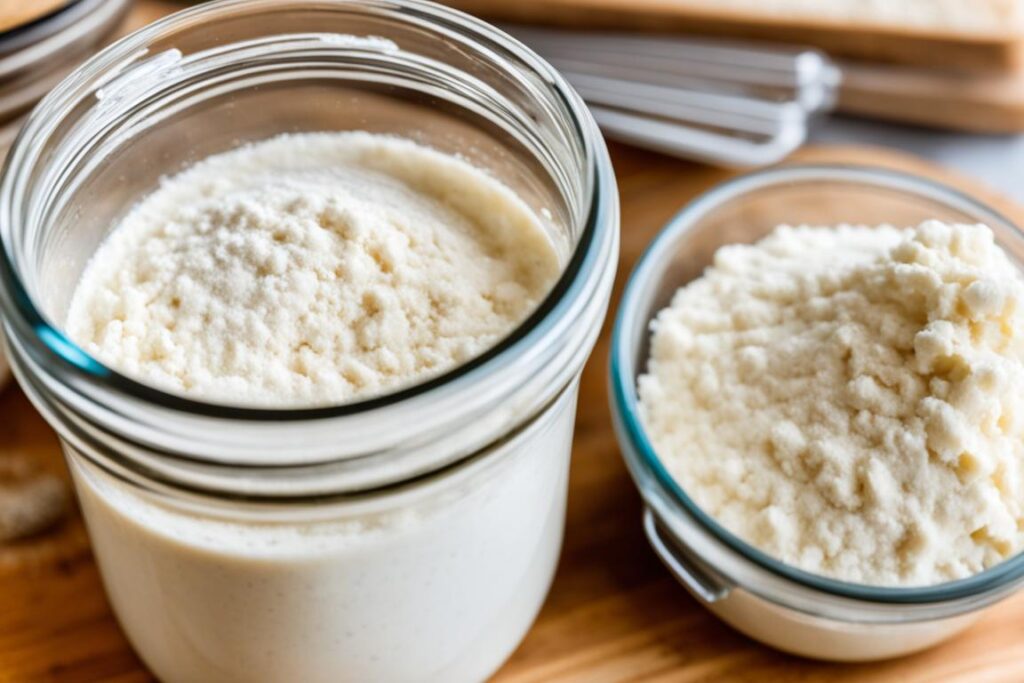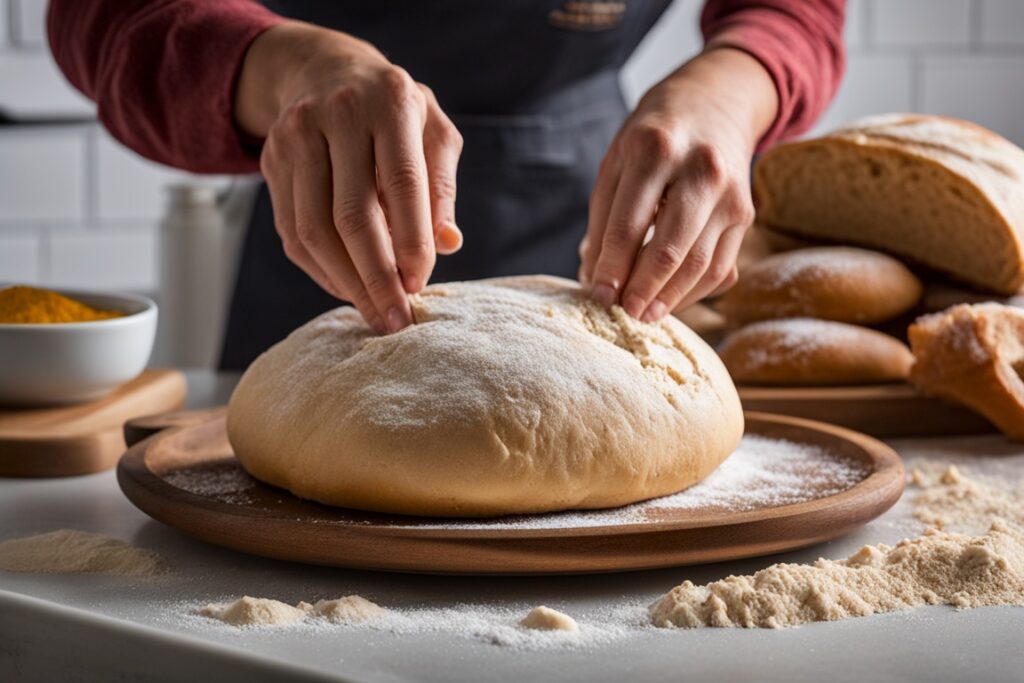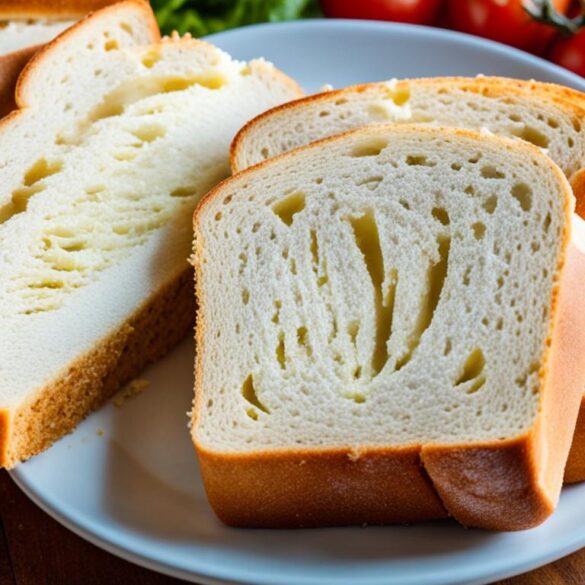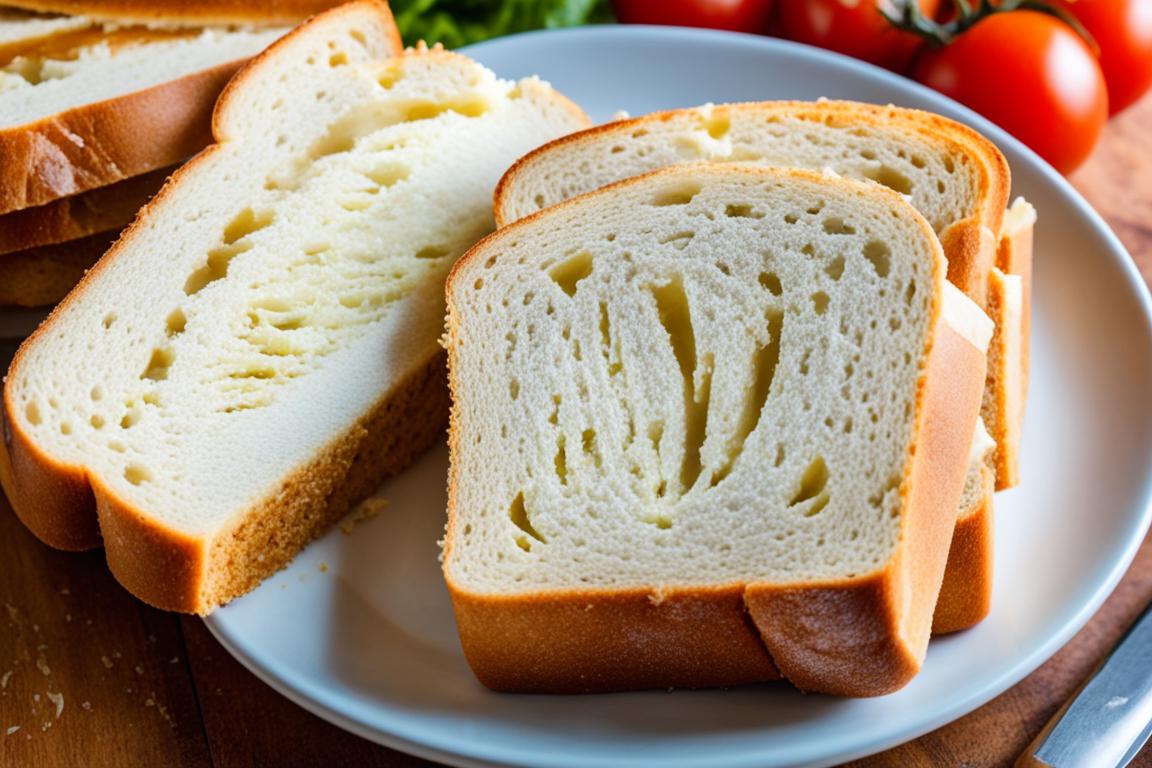Learn how to bake a sourdough sandwich bread that’s full of tangy flavor and chewy texture. This guide will show you how to make an artisan-style loaf at home. It doesn’t matter if you’re new to bread baking or have been doing it for years. You’ll make a sourdough sandwich bread that will wow your family and friends.
Sourdough bread has a long history, starting in the San Francisco Bay Area. It’s made with fermented dough, which creates a tangy taste and a chewy, crusty texture. We’ll guide you from making a strong sourdough starter to baking the perfect sourdough sandwich bread loaf.
Key Takeaways
- Discover the art of crafting artisan-style sourdough sandwich bread at home
- Learn how to develop a flavorful sourdough starter, the foundation of your bread
- Master the techniques for mixing, kneading, and shaping your sourdough dough
- Achieve the perfect baking temperature and timing for a crusty, chewy sourdough loaf
- Explore delicious sourdough sandwich bread variations with added flavors and inclusions
The Art of Sourdough Sandwich Bread
Making the perfect sourdough sandwich bread is a labor of love. It’s filled with tradition and needs patience. This bread shows the power of long fermentation, giving it a tangy flavor and chewy texture. We’ll learn the secrets of San Francisco sourdough and how to make artisan bread at home.
Embracing Tradition and Patience
Sourdough sandwich bread isn’t rushed. It’s a process that needs your focus and care. The long fermentation, often taking several hours or days, makes this bread special. By letting the dough develop slowly, you get a flavor depth that quick methods can’t match.
Unlocking Tangy Flavors
The tangy taste of sourdough comes from natural fermentation. Wild yeast and beneficial bacteria in the sourdough starter work to turn simple ingredients into a flavor explosion. This process not only boosts the taste but also makes the bread’s chewy texture and easier to digest.
“Sourdough bread is a labor of love, but the end result is well worth the wait. The depth of flavor and satisfying chew are unparalleled.”
Whether you’re new to sourdough or experienced, the journey to make the perfect artisan bread loaf is rewarding. Discover sourdough’s secrets and improve your sandwiches with a remarkable San Francisco sourdough loaf.
Essential Ingredients for Sublime Sourdough
Making a delicious sourdough sandwich bread starts with choosing the right high-quality ingredients. The right flour and water are key to getting the perfect texture and taste. Each ingredient is vital for a great loaf.
Choosing the right flour is the first step. Use a mix of artisan bread flours like bread flour and whole wheat flour. These flours are full of gluten and nutrients. They help make a sourdough that’s both strong and light.
Getting the water-to-flour ratio right is also crucial. The right amount of water makes your sourdough starter work its best. Keep trying different water levels until you get the perfect sourdough every time.
Adding a bit of high-quality salt to your dough makes the flavors pop. It brings out the sour taste of the sourdough and matches well with other ingredients. A little honey or maple syrup can also add a sweet touch that balances the sourness.
By carefully picking and using these key ingredients, you’re on your way to making a sourdough sandwich bread that’s both delicious and impressive.
Sourdough Starter: The Foundation of Flavor
Every delicious sourdough sandwich bread starts with a strong sourdough starter. This fermented dough gives the bread its natural rise and that tangy taste we adore. We’ll show you how to grow and keep your sourdough starter. This way, you’ll always have the magic for your baking.
Cultivating and Maintaining Your Starter
Creating a healthy sourdough starter needs patience and hard work. But, the results are amazing. Here’s how to start:
- Start with a little flour and water. Let it ferment at room temperature for 24 to 48 hours, and feed it often.
- As the sourdough starter gets better, it will bubble and become more active. This means the good yeast and bacteria are there, ready to add flavor.
- When your starter doubles in size after feeding, you can use it in your baking. Keep it healthy by feeding and refreshing it regularly.
“A well-cared-for sourdough starter is the key to unlocking a world of flavor in your baked goods.”
Storing and feeding your sourdough starter right is key to its health and readiness. Try different flours, temperatures, and feeding times to find what works best for your starter.

With time and effort, you’ll have a lively sourdough starter. It will make your fermented dough and sourdough sandwich bread taste amazing.
Mixing and Kneading Techniques
Learning how to mix and knead sourdough dough is key to making a great loaf. The way you handle and work the dough affects its texture and crumb. Let’s look at the best ways to mix your ingredients and knead the dough.
Achieving the Perfect Dough Consistency
The consistency of your sourdough dough is crucial. A dough that’s well-developed and pliable is important for baking. Here are some tips to get the dough right:
- Use the right mix of water, flour, and sourdough starter. This mix affects the dough’s texture.
- Knead the dough well to build the gluten structure. This makes the dough smooth, elastic, and well-hydrated.
- Check how the dough looks and feels. It should be a bit tacky but not too sticky, with a smooth surface.
Getting the dough just right is about balancing hydration, gluten development, and workability. Mastering these skills will help you succeed in making sourdough bread.
“The key to a well-developed sourdough dough lies in the kneading technique. Spend the time to knead your dough until it becomes smooth and elastic, and you’ll be rewarded with a beautiful, well-risen loaf.”
Shaping and Proofing Your Sourdough Loaf
Making the perfect sourdough sandwich bread is a mix of skill and patience. After mixing and kneading the dough well, it’s time to shape and proof the loaf. This step lets the gluten relax and the flavors grow, making the crumb just right.
Shaping your sourdough loaf is like creating art. Begin by gently getting rid of air bubbles. Then, use gentle stretches and folds to make the dough into a tight loaf. This makes the loaf look beautiful and helps its structure.
The proofing stage is just as vital. Put your shaped loaf in a pan or on a baking sheet lined with parchment. Let it proof at the best temperature and time. This lets the yeast work, the gluten relax, and the flavors get stronger, making the crumb light and airy.
- Gently degas the dough to release any excess air bubbles.
- Use a series of gentle stretches and folds to shape the dough into a tight, cohesive loaf.
- Place the shaped loaf in a lightly greased pan or on a parchment-lined baking sheet.
- Proof the sourdough loaf at the optimal temperature and duration to allow the yeast to ferment and the flavors to develop.
Learning how to shape and proof your sourdough loaf well will help you bake a loaf that looks great and tastes amazing. Being patient and paying attention to details is important. But, the results are totally worth it.
“The true magic of sourdough lies in the patient, meticulous process of shaping and proofing the dough.”
Baking Your Sourdough Sandwich Bread
Mastering the baking stage is key to making your sourdough sandwich bread delicious. You need to know the right oven temperature and timing for a crisp crust and soft crumb.
Temperature and Timing Mastery
Heat your oven to a high 450°F (230°C). This temperature makes a golden-brown crust that keeps the tangy sourdough flavors inside. Put the dough on a lightly oiled baking sheet or Dutch oven when it’s ready.
Bake your sourdough sandwich bread for about 25-30 minutes. For the first 15 minutes, add steam to the oven with a pan of hot water on the lower rack. This helps make the sourdough crust.
After 15 minutes, take out the steam pan and bake for another 10-15 minutes. The crust should be a deep golden color. Turn the pan halfway through to bake evenly.
When the bread’s internal temperature hits 205°F (96°C), it’s done. Let it cool on a wire rack before you slice and enjoy its great texture and taste.

“The true magic of sourdough lies in the patient, precise techniques that transform simple ingredients into a masterpiece of flavor and texture.”
Sourdough Sandwich Bread Variations
The classic sourdough sandwich bread is a treat, but why not try something new? We’ll show you how to make your sourdough loaf special with flavors and inclusions. Add herbs, nuts, or dried fruits to create a unique sourdough sandwich bread.
Experimenting with Flavors and Inclusions
Sourdough bread lets you be creative and try new flavor variations. Here are some ingredients to spice up your sourdough sandwich bread:
- Herbs and Spices: Rosemary, thyme, garlic, and chili flakes can make your bread aromatic and savory.
- Nuts and Seeds: Toasted walnuts, pecans, or sunflower seeds add crunch and nutty flavor.
- Dried Fruits: Chopped apricots, cranberries, or figs bring sweetness and chewiness to your sourdough sandwich bread.
- Cheese: Grated parmesan or crumbled feta adds a savory, umami-rich taste.
Try different flavor variations to find what you like best. Enjoy baking and let your creativity flow!
“Bread is the foundation of all food. It’s the staff of life. Without bread, a meal is not a meal.”
Storing and Serving Sourdough Sandwich Bread
Mastering sourdough sandwich bread baking is just the start. Ensuring it stays fresh and flavorful is key. Proper storage and serving tips can help you enjoy your homemade bread to the fullest.
Storing Your Sourdough Bread
Here are easy ways to keep your sourdough bread fresh:
- Store the loaf at room temperature, wrapped in a clean kitchen towel or paper bag. This keeps the crust crisp.
- For longer storage, refrigerate it. Use a resealable plastic bag or an airtight container to keep it from drying out.
- Freeze your sourdough loaf for up to 3 months. Wrap it in plastic wrap or foil, then put it in a freezer-safe bag or container.
Enjoying Your Sourdough Bread
There are many ways to enjoy your homemade sourdough sandwich bread. Here are some tasty ideas:
- Slice the bread for your favorite sandwiches, like turkey, cheese, or avocado.
- Toast the bread and top it with creamy avocado, honey, and sea salt.
- For breakfast, toast sourdough with a fried egg and fresh herbs.
“The key to enjoying sourdough bread is to savor its unique flavor and texture. With proper storage and creative serving ideas, you can make the most of your homemade loaf.”
By using these tips, your sourdough sandwich bread will stay fresh and delicious. You can enjoy it in many ways.
Conclusion
In this guide, you’ve learned how to bake delicious sourdough sandwich bread at home. You now know how to make a sourdough starter and the steps for mixing, shaping, and baking. This gives you the skills to make an amazing loaf that will wow your family and friends.
Creating sourdough bread requires patience and care. But the reward is worth it. You’ll love the tangy taste and chewy texture of your homemade sourdough.
If you’re new to baking or experienced, you can master artisan baking. Start this fun journey and improve your sandwich bread game. It’s a great way to make your sandwiches even better.
There’s nothing like biting into a slice of your homemade sourdough sandwich bread. Enjoy the moment and share your bread with others. Take pride in your culinary creation. Happy baking!
FAQ
What is the key to achieving the perfect sourdough flavor and texture?
The secret to perfect sourdough is a long fermentation. This slow process lets the natural yeasts and bacteria in the starter develop deep flavors. It also makes the bread chewy and crusty.
How do I maintain a healthy sourdough starter?
Keeping your sourdough starter healthy is key for great bread. You need to feed it regularly, store it right, and control the temperature. Feed it flour and water equally and keep it at the right temperature to keep it active.
What’s the difference between sourdough sandwich bread and regular sandwich bread?
Sourdough sandwich bread is different because of its longer fermentation. This process gives it a tangy taste and chewy texture. Regular sandwich bread, on the other hand, uses commercial yeast for a lighter crumb.
How do I achieve the perfect crust on my sourdough sandwich bread?
For a perfect crust, use high oven temperatures and steam. Make sure the dough is well-proofed. Let the loaf cool before slicing to get a crisp crust.
Can I add mix-ins or variations to my sourdough sandwich bread?
Yes! You can add many mix-ins and flavors to sourdough bread. Try using herbs, nuts, seeds, dried fruits, or cheese for a unique taste.
How do I store and preserve my homemade sourdough sandwich bread?
Store your sourdough at room temperature in a paper or cloth bag for up to 5 days. Don’t use plastic as it can make the crust soft. For longer storage, freeze sliced bread for up to 3 months.

Sourdough Sandwich Bread
Equipment
- Mixing Bowl
- Baking Sheet
- Dutch Oven
- Wire Rack
Ingredients
Essential Ingredients
- 3 cups Bread Flour Use high-quality bread flour for best results.
- 1 cup Whole Wheat Flour Adds flavor and nutrients.
- 1.5 cups Water Adjust based on dough consistency.
- 1 tablespoon Salt Enhances flavor.
- 1 tablespoon Honey Optional, for a touch of sweetness.
- 1 cup Sourdough Starter Active and bubbly starter is essential.
Instructions
- In a large mixing bowl, combine bread flour, whole wheat flour, and salt.
- Add the sourdough starter, honey, and water to the dry ingredients. Mix until a shaggy dough forms.
- Knead the dough on a floured surface for about 10 minutes until smooth and elastic.
- Place the dough in a greased bowl, cover, and let it rise for 4-6 hours or until doubled in size.
- Preheat your oven to 450°F (230°C) and place a Dutch oven inside to heat.
- Once risen, shape the dough into a loaf and place it in a greased pan or on parchment paper.
- Let the loaf proof for another 30-60 minutes.
- Carefully remove the hot Dutch oven, place the dough inside, cover, and bake for 15 minutes.
- Remove the lid and bake for an additional 10-15 minutes until golden brown and the internal temperature reaches 205°F (96°C).
- Let the bread cool on a wire rack before slicing.

